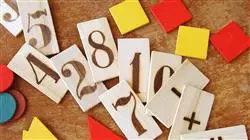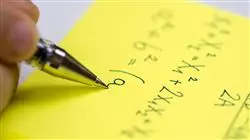University certificate
The world's largest faculty of education”
Introduction to the Program
Update your didactic knowledge and design your educational units from start to finish with the best academic option”

The Didactics of Mathematics was born in France in 1970 and since then many researchers have dedicated their time to improve the learning of such a vital subject for the academic and professional development of people.
These studies have made it possible to delve into teaching methods, as well as the functioning of the human brain itself, in order to acquire mathematical concepts such as algebra, geometry or statistics. This is a daily task for the teacher who must bring numbers to teen students in an attractive way. In this line, TECH has designed this Postgraduate certificate in Didactics of Mathematics in Secondary Education in 100% online modality.
This is an advanced program of 375 teaching hours, where students delve into the cognitive and metacognitive processes, memory, attention or the relationship of high abilities and giftedness with mathematics. In addition, this program will allow you to design a didactic unit, taking into account the educational level and all the elements (methods, objectives, resources and evaluation) that it must contain.
A Postgraduate certificate designed by and for today's teachers who must know how to adapt their teaching to the diversity of the classroom and do it in an attractive way. To make this task even easier, TECH provides case studies, elaborated by specialized professionals, which will help them to create their own successful didactic units.
The teaching professionals are therefore faced with an unparalleled opportunity to perfect their classroom competencies through a program that they can access whenever and wherever they wish. It only need a an electronic device with Internet connection to be able to visualize, at any time, the contents hosted on the virtual platform.
Take a step forward in your teaching career through a 100% online and flexible Postgraduate certificate”
This Postgraduate certificate in Didactics of Mathematics in High School contains the most complete and up-to-date educational program on the market. The most important features include:
- The examination of case studies presented by experts in Didactics of Mathematics in High School Education
- The graphic, schematic and practical contents of the book provide technical and practical information on those disciplines that are essential for professional practice
- Practical exercises where self-assessment can be used to improve learning
- Its special emphasis on innovative methodologies
- Theoretical lessons, questions to the expert, debate forums on controversial topics, and individual reflection assignments
- Content that is accessible from any fixed or portable device with an Internet connection
Enhance your work as a teacher through an advanced and dynamic syllabus thanks to the numerous additional resources provided by TECH”
The program's teaching staff includes professionals from the sector who contribute their work experience to this program, in addition to renowned specialists from leading societies and prestigious universities.
The multimedia content, developed with the latest educational technology, will provide the professional with situated and contextual learning, i.e., a simulated environment that will provide immersive education programmed to learn in real situations.
The design of this program focuses on Problem-Based Learning, by means of which the professional must try to solve the different professional practice situations that are presented throughout the academic course. For this purpose, the students will be assisted by an innovative interactive video system created by renowned and experienced experts.
Case studies provided by the excellent teaching team will guide you to successfully design your mathematics didactic units"

This Postgraduate certificate will give you a plus to your teaching work by applying the most innovative didactics according to the educational level of your students"
Why study at TECH?
TECH is the world’s largest online university. With an impressive catalog of more than 14,000 university programs available in 11 languages, it is positioned as a leader in employability, with a 99% job placement rate. In addition, it relies on an enormous faculty of more than 6,000 professors of the highest international renown.

Study at the world's largest online university and guarantee your professional success. The future starts at TECH”
The world’s best online university according to FORBES
The prestigious Forbes magazine, specialized in business and finance, has highlighted TECH as “the world's best online university” This is what they have recently stated in an article in their digital edition in which they echo the success story of this institution, “thanks to the academic offer it provides, the selection of its teaching staff, and an innovative learning method aimed at educating the professionals of the future”
A revolutionary study method, a cutting-edge faculty and a practical focus: the key to TECH's success.
The most complete study plans on the university scene
TECH offers the most complete study plans on the university scene, with syllabuses that cover fundamental concepts and, at the same time, the main scientific advances in their specific scientific areas. In addition, these programs are continuously being updated to guarantee students the academic vanguard and the most in-demand professional skills. In this way, the university's qualifications provide its graduates with a significant advantage to propel their careers to success.
TECH offers the most comprehensive and intensive study plans on the current university scene.
A world-class teaching staff
TECH's teaching staff is made up of more than 6,000 professors with the highest international recognition. Professors, researchers and top executives of multinational companies, including Isaiah Covington, performance coach of the Boston Celtics; Magda Romanska, principal investigator at Harvard MetaLAB; Ignacio Wistumba, chairman of the department of translational molecular pathology at MD Anderson Cancer Center; and D.W. Pine, creative director of TIME magazine, among others.
Internationally renowned experts, specialized in different branches of Health, Technology, Communication and Business, form part of the TECH faculty.
A unique learning method
TECH is the first university to use Relearning in all its programs. It is the best online learning methodology, accredited with international teaching quality certifications, provided by prestigious educational agencies. In addition, this disruptive educational model is complemented with the “Case Method”, thereby setting up a unique online teaching strategy. Innovative teaching resources are also implemented, including detailed videos, infographics and interactive summaries.
TECH combines Relearning and the Case Method in all its university programs to guarantee excellent theoretical and practical learning, studying whenever and wherever you want.
The world's largest online university
TECH is the world’s largest online university. We are the largest educational institution, with the best and widest online educational catalog, one hundred percent online and covering the vast majority of areas of knowledge. We offer a large selection of our own degrees and accredited online undergraduate and postgraduate degrees. In total, more than 14,000 university degrees, in eleven different languages, make us the largest educational largest in the world.
TECH has the world's most extensive catalog of academic and official programs, available in more than 11 languages.
Google Premier Partner
The American technology giant has awarded TECH the Google Google Premier Partner badge. This award, which is only available to 3% of the world's companies, highlights the efficient, flexible and tailored experience that this university provides to students. The recognition as a Google Premier Partner not only accredits the maximum rigor, performance and investment in TECH's digital infrastructures, but also places this university as one of the world's leading technology companies.
Google has positioned TECH in the top 3% of the world's most important technology companies by awarding it its Google Premier Partner badge.
The official online university of the NBA
TECH is the official online university of the NBA. Thanks to our agreement with the biggest league in basketball, we offer our students exclusive university programs, as well as a wide variety of educational resources focused on the business of the league and other areas of the sports industry. Each program is made up of a uniquely designed syllabus and features exceptional guest hosts: professionals with a distinguished sports background who will offer their expertise on the most relevant topics.
TECH has been selected by the NBA, the world's top basketball league, as its official online university.
The top-rated university by its students
Students have positioned TECH as the world's top-rated university on the main review websites, with a highest rating of 4.9 out of 5, obtained from more than 1,000 reviews. These results consolidate TECH as the benchmark university institution at an international level, reflecting the excellence and positive impact of its educational model.” reflecting the excellence and positive impact of its educational model.”
TECH is the world’s top-rated university by its students.
Leaders in employability
TECH has managed to become the leading university in employability. 99% of its students obtain jobs in the academic field they have studied, within one year of completing any of the university's programs. A similar number achieve immediate career enhancement. All this thanks to a study methodology that bases its effectiveness on the acquisition of practical skills, which are absolutely necessary for professional development.
99% of TECH graduates find a job within a year of completing their studies.
Postgraduate Certificate in Didactics of Mathematics in High School
At TECH Global University, our main objective is to provide the best training available in the different areas of knowledge that govern society. To continue fulfilling our goal, from the largest online Faculty of Education in the world, we designed the Postgraduate Certificate in Teaching Mathematics in High School as an excellent opportunity for academic qualification for all individuals with an interest in improving their work practice. Our program consists of 375 instructional hours, during which students will have access to high quality contents together with a state-of-the-art multimedia system. In addition, throughout the program they will obtain different skills to implement innovative pedagogical strategies that, in turn, promote the development of mathematical thinking and related areas.
Postgraduate Certificate in Teaching Mathematics in High School 100% online
The TECH program has an experienced and qualified faculty in the educational field, thanks to this, students will be qualified by the hand of experts in the field that will ensure to provide excellent content in the following topics: cognitive processes, definition of learning, neural bases, sustained attention, as well as other conceptual areas of great importance to consolidate optimally in the pedagogical sector. Upon successful completion of the proposed syllabus, students will be awarded a university certificate of international recognition and prestige.







